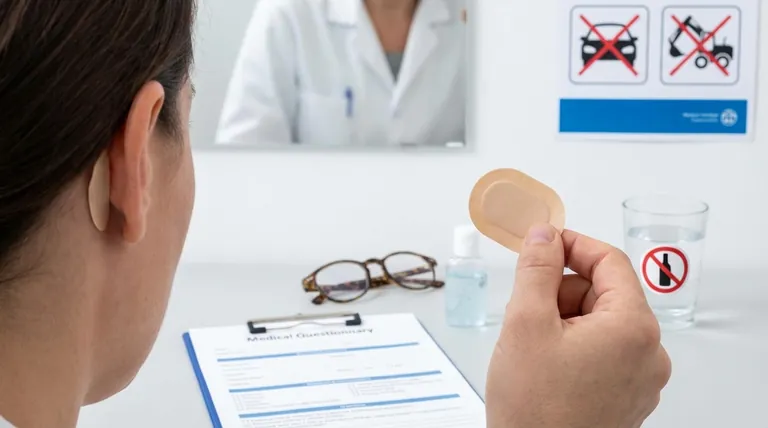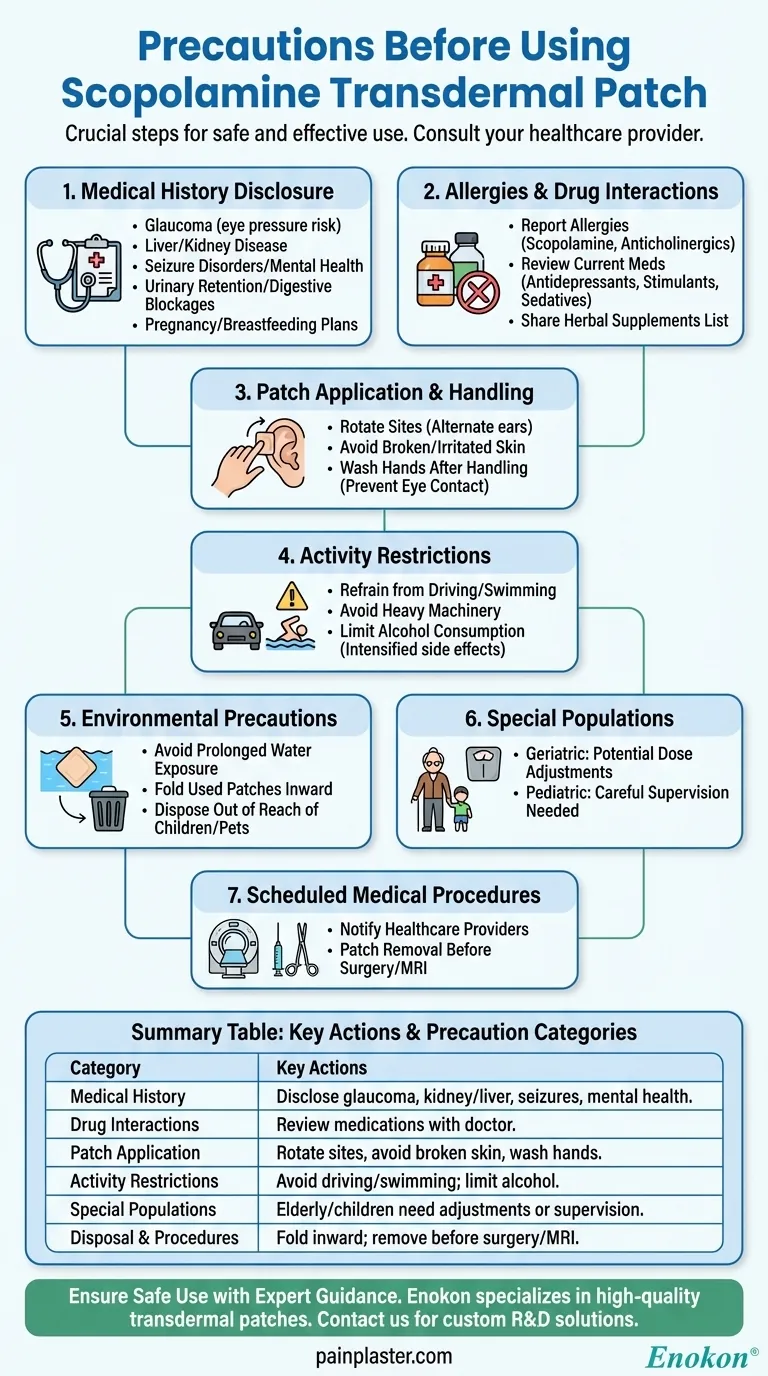Before using a Scopolamine Transdermal Patch, it's crucial to take several precautions to ensure safe and effective use. Key considerations include discussing your medical history (e.g., glaucoma, kidney/liver disease, seizures, mental health conditions), current medications, and pregnancy/breastfeeding status with your healthcare provider. Proper application and disposal techniques, avoiding eye contact, and being mindful of potential side effects like drowsiness or blurred vision are also essential. Rotating application sites, limiting water exposure, and avoiding alcohol can further enhance safety.

Key Points Explained:
-
Medical History Disclosure
- Inform your doctor about pre-existing conditions such as:
- Glaucoma (risk of increased eye pressure)
- Liver or kidney disease (altered drug metabolism)
- Seizure disorders or mental health conditions (potential exacerbation)
- Urinary retention or digestive blockages (anticholinergic effects may worsen symptoms)
- Disclose pregnancy or breastfeeding plans, as scopolamine may affect fetal development or pass into breast milk.
- Inform your doctor about pre-existing conditions such as:
-
Allergies and Drug Interactions
- Report any known allergies to scopolamine or similar medications (e.g., anticholinergics).
- Share a list of current medications, including:
- Antidepressants (e.g., MAO inhibitors)
- Stimulants or sedatives
- Herbal supplements (potential interactions)
-
Patch Application and Handling
- Rotate application sites (e.g., behind alternate ears) to prevent skin irritation.
- Avoid applying to broken or irritated skin, or near the breasts if breastfeeding.
- Wash hands thoroughly after handling the patch to prevent accidental eye exposure, which can cause pupil dilation and blurred vision.
-
Activity Restrictions
- Refrain from driving, swimming, or operating heavy machinery until you know how scopolamine affects you, as it may cause drowsiness or dizziness.
- Limit alcohol consumption, which can intensify side effects like sedation.
-
Environmental Precautions
- Avoid prolonged water exposure (e.g., swimming, long baths) to prevent the patch from loosening.
- Dispose of used patches by folding them sticky-side inward and placing them out of reach of children/pets.
-
Special Populations
- Geriatric patients may require dose adjustments due to increased sensitivity.
- Pediatric use should be carefully supervised due to higher risk of side effects.
-
Scheduled Medical Procedures
- Notify healthcare providers if you’re scheduled for surgery or an MRI, as the patch may need removal.
By addressing these factors proactively, patients can minimize risks while maximizing the therapeutic benefits of scopolamine for motion sickness or nausea management. Always consult a healthcare professional for personalized guidance.
Summary Table:
| Precaution Category | Key Actions |
|---|---|
| Medical History | Disclose glaucoma, kidney/liver disease, seizures, or mental health conditions. |
| Drug Interactions | Review current medications (e.g., antidepressants, sedatives) with your doctor. |
| Patch Application | Rotate sites, avoid broken skin, and wash hands after handling. |
| Activity Restrictions | Avoid driving/swimming until effects are known; limit alcohol. |
| Special Populations | Elderly/children may need adjusted doses or supervision. |
| Disposal & Procedures | Fold used patches inward; remove before surgery/MRI. |
Ensure Safe Use of Scopolamine Patches with Expert Guidance
At Enokon, we specialize in manufacturing high-quality transdermal patches, including scopolamine formulations, for healthcare distributors and brands. Our team offers technical support for custom R&D to meet your specific needs. Contact us today to discuss safe, effective transdermal solutions tailored to your requirements.
Visual Guide

Related Products
- Far Infrared Heat Pain Relief Patches Transdermal Patches
- Heating Pain Relief Patches for Menstrual Cramps
- Herbal Eye Protection Patch Eye Patch
- Far Infrared Deep Heat Relief Patches Medicated Pain Relief Patches
- Capsaicin Chili Medicated Pain Relief Patches
People Also Ask
- What are the key features of the Deep Heat Pain Relief Back Patch? Get Up to 16 Hours of Drug-Free Relief
- How quickly does the Deep Heat Pain Relief Back Patch activate and how long does it provide warmth? Get 16-Hour Relief
- What types of pain can the Deep Heat Pain Relief Back Patch be used for? Targeted Relief for Muscles & Joints
- How does the Deep Heat Back Patch work? A Drug-Free Solution for Targeted Pain Relief
- How does capsaicin work in the medicated heat patch? The Science Behind Pain Relief














